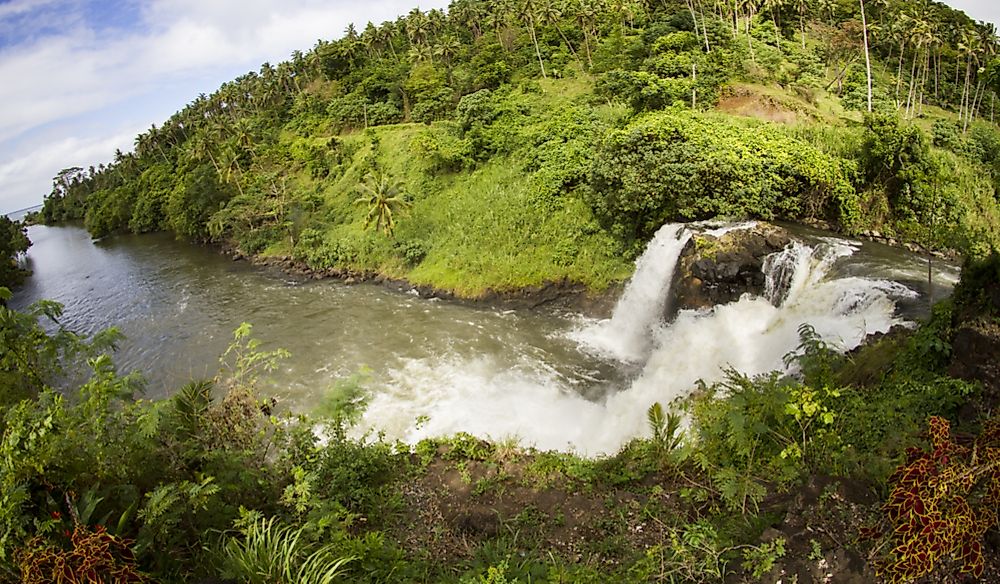What Are The Major Natural Resources Of Samoa?

Samoa is a country composed of several islands, two large and four small, in the Pacific Ocean. The economy of Samoa is classified as a developing economy by major financial institutions such as the World Bank. In 2017, Samoa had a gross domestic product (GDP) of $857 million, which ranked 177th in the world. However, the country's per capita GDP was much higher, ranking 103rd, according to the World Bank. The economy of Samoa is largely dependent on natural resources such as water, fish, arable land, and the country's beautiful scenery.
Samoa's Natural Resources
Arable Land
Arable land, which covers roughly 2.8% of Samoa's total area, is one of the country's most important natural resources. According to data from the World Bank, the amount of arable land decreased significantly between 2004 and 2010, but remained relatively constant from 2011 until 2014. Agriculture is one of Samoa's most important economic sectors, as it contributed 10.4% of the country's GDP in 2017, and employed approximately 66% of the nation's workforce. However, despite the high number of Samoans involved in the agricultural sector, the majority of the country's food is imported. Most farmers in Samoa practice subsistence farming, growing crops such as bananas, taro, and yams for local consumption. Samoan farmers also grow a variety of cash crops, such as coconuts and cocoa. Plantation agriculture in Samoa is common and is mainly practiced by foreign residents. Samoa's agricultural sector faces several significant challenges, such as natural disasters, diseases, and climate change. Rising sea levels caused by climate change pose a significant threat, given that most of the country is situated in low-lying coastal areas. The government of Samoa has partnered with local farmers to improve the country's agriculture sector by promoting sustainable practices.
Coconuts
The coconut is one of Samoa's most important crops. The crop is considered vital because it can be used for a variety of purposes besides a food source. For example, Samoa's coconuts are used to produce coconut oil, which is mainly exported to other nations. A botanical study conducted in 2017 by Samoa's Ministry of Agriculture identified nearly 80 varieties of coconuts grown throughout the country. During the 1990s, Samoa's coconut production declined significantly due to a decline in global coconut prices. However, by 1999, Samoa's coconut industry had recovered and produced approximately 130,000 tons of coconuts. Another major threat to coconut production in Samoa is the age of the country's trees. A recent study indicated that almost 80% of Samoa's coconut trees were old and needed to be replaced. As a result, the Ministry of Agriculture hoped to replace nearly 90% of the country's coconut trees within five years by partnering with local communities.
Beautiful Scenery
Samoa's beautiful scenery is one of its most important natural resources, as it attracts large numbers of tourists each year. Some of the most beautiful natural features in Samoa include sandy beaches, waterfalls, and nature trails. For example, the Afu Aau Waterfall, which is situated in the southeastern part of Savaii, is popular because visitors can swim in a pool at the waterfall's bottom. Another popular waterfall in Samoa is the Togitogiga Waterfall, which is situated in the village of Saleilua, and historically served as a popular swimming spot for Samoan warriors. Samoa's vibrant tourism industry has attracted several investors who have established many hotels and resorts. Additionally, the government of Samoa has invested heavily in improving the country's tourism industry, especially through the creation of the Samoa Tourism Authority. The authority is responsible for promoting Samoa internationally as a tourist destination. The Samoan government also urges locals to visit the tourist destinations around the country as a means of reducing the reliance on foreign visitors.
Fish
There are several fish species within Samoa's territorial waters, such as tuna, marlin, and sailfish. Fishing in Samoa is mainly divided into three categories: subsistence fishing, commercial fishing, and sport fishing. Subsistence fishing is primarily practiced by local communities to supplement their diets. Local Samoan communities typically fish in small vessels, such as canoes, using traditional methods like spearing and hook lines. In 1999, the Samoan government estimated that subsistence fishing caught a combined 4,300 tons of fish. Commercial fishing is one of the country's most important economic activities, as it generates significant income. Most commercial fishing in Samoa occurs outside the reefs, and the most common variety of fish commercially caught is tuna. The Samoan government has also encouraged the fishing industry to practice fish farming as a means of increasing the country's fish reserves. Sport or leisure fishing in Samoa is popular among tourists.
Water
One of Samoa's most important natural resources is water, especially in the generation of hydroelectricity. There are several major hydropower projects in Samoa such as the Loto Samasoni Project, Alaoa Plant, and the Fale o le Fe'e Project. Some of Samoa's hydropower projects were damaged by Cyclone Evan, and the government sought the assistance of several international organizations such as the European Union (EU) and the Asian Development Bank to repair the destroyed plants. In 2019, the Samoan government commissioned a 460 KW hydropower plant.
Forests
Forest covers vast areas of Samoa, especially tropical moist forests. The Samoan government estimates that tropical moist forests cover roughly 1,200 square miles of the country's total area. These forests are home to some of Samoa's most important species, most of which are endemic to the country, such as the tooth-billed pigeon.
Challenges Facing the Samoan Economy
The Samoan economy faces several challenges such as natural disasters and a high unemployment rate. Cyclone Val was a major natural disaster that negatively impacted the Samoan economy, causing millions of dollars in damages. In 2017, Samoa's unemployment rate was 8.21%, which was a slight decrease from 8.49% in 2016. However, the Samoan government has introduced several measures intended to help reduce the country's unemployment rate.











